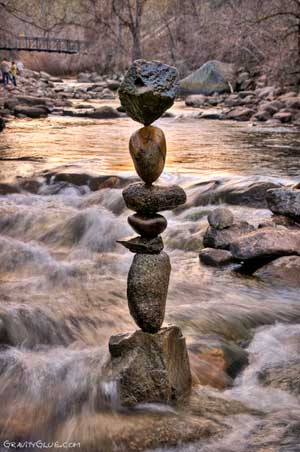 Michael Grab
Michael Grab has been creating unbelievable works of land art around Boulder, Colorado. Inspired by Yoda’s maxim, “Try not. Do. Or do not. There is no try,” Grab demonstrates that with a bit of patience, it’s possible to create a Jedi-like sense of balance in the unlikeliest arrangements of rocks. The artist writes that he uses rocks he finds out in the woods to create his “meditative nature” sculptures.
Grab argues that many civilizations have practiced the art of balancing rocks. But he’s not interested in making some broad statement about culture and nature. He mostly finds the work therapeutic.
He writes: “Over the past few years of practicing rock balance, simple curiosity has evolved into therapeutic ritual, ultimately nurturing meditative presence, mental well-being, and artistry of design. Alongside the art, setting rocks into balance has also become a way of showing appreciation, offering thanksgiving, and inducing meditation. Through manipulation of gravitational threads, the ancient stones become a poetic dance of form and energy, birth and death, perfection and imperfection.”
In the arrangement of rocks, he finds a reflection of ourselves. The pieces are “precariously sturdy, mysterious, and fragile.”

The arrangements themselves are a thing of wonder for him. “One of the most lovely experiences in practicing rock balance is the unspoken dialogue between the rocks, the surrounding environment and my own creative flow.” Indeed, some pieces may even compete with
Brancusi’s African totem-inspired sculptures.


Getting the emotional and aesthetic experience, many landscape architects might ask, how the hell do you do that? Grab writes that the key is to find some sort of “tripod” for the rock to be placed on. “Every rock is covered in a variety of tiny to large indentations that can act as a tripod for the rock to stand upright, or in most orientations you can think of with other rocks. By paying close attention to the feeling of the rocks, you will start to feel even the smallest clicks as the notches of the rocks in contact are moving over one another. In the finer point balances, these clicks can be felt on a scale smaller than millimeters.” And while mastering the mechanics is important, Grab says that anyone practicing rock balancing must “get to know the rocks you are working with.”
Image credit: copyright Michael Grab / Gravity Glue





